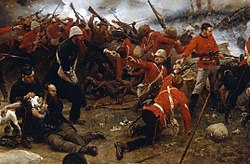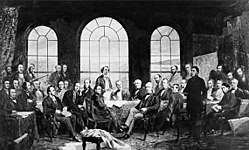Early period
In 1832, after much political agitation, the Great Reform Act was passed . It abolished many tiny seats and created new seats for the fast-growing cities. It expanded the franchise in England and Wales (a Scottish Reform Act and Irish Reform Act were passed separately). [1]
On 20 June 1837, Victoria became Queen of the United Kingdom on the death of her uncle, King William IV, just weeks after reaching the age of eighteen. Her government was led by the Whig prime minister Lord Melbourne, to whom she was close. [2]
Britain sent Lord Durham to Canada to resolve its constitutional crisis. His Durham Report in 1839 opened the way for "responsible government" (that is, self-government). [3] [4] [5]
In 1839, a seizure of British opium exports to China prompted the First Opium War against the Qing dynasty.
British defense of India initiated the First Anglo-Afghan War—one of the first major conflicts of the Great Game between Britain and Russia. [6]
In South Africa, the Dutch Boers made their Great Trek to found Natal, the Transvaal, and the Orange Free State, defeating the Zulus in the process, 1835–1838; Britain annexed Natal in 1843 but recognised the independence of the Transvaal in 1852 in the Orange Free State in 1854. [4] [5]

In 1840, Queen Victoria married her German cousin Prince Albert of Saxe-Coburg-Saalfield. It proved a passionate marriage, whose children were much sought after by royal families across Europe. An astute diplomat, the Queen was only too willing to arrange such marriages. Indeed, she became the "Grandmother of Europe" thanks to the nine children she had with Prince Albert in just sixteen years despite suffering from postnatal depression and her dislike of childbirth. Unfortunately, she carried the gene for haemophilia, which affected ten of her male descendants, including the heir apparent of Tsar Nicholas II. [2] [7]
In Australia, new provinces were founded with Victoria in 1835 and South Australia in 1842. The focus shifted from transportation of criminals to voluntary immigration. New Zealand became a British colony in 1839; in 1840 Maori chiefs ceded sovereignty to Britain in Treaty of Waitangi. In 1841 New Zealand became an autonomous colony. [4] [5] The signing of the Treaty of Nanking in 1842 ended the First Opium War and gave Britain control over Hong Kong Island. [5] However, a disastrous retreat from Kabul in the same year led to the annihilation of a British army column in Afghanistan. The Massacre of Elphinstone's Army by the Afghans results in the death or incarceration of 16,500 soldiers and civilians. [8]
In Ireland in 1845, the Great Famine began to cause mass starvation, disease and death, sparking large-scale emigration. [9] To allow more cheap food into Ireland, the Peel government repealed the Corn Laws.

In Australia the gold rush began in 1851 In ten years the Australian population nearly tripled. [10]
In 1853, Britain fought alongside France in the Crimean War against Russia. The goal was to ensure that Russia could not benefit from the declining status of the Ottoman Empire, [11] a strategic consideration known as the Eastern Question. The conflict marked a rare breach in the Pax Britannica , the period of relative peace (1815–1914) that existed among the Great Powers of the time, and especially in Britain's interaction with them. On its conclusion in 1856 with the Treaty of Paris, Russia was prohibited from hosting a military presence in Crimea. It was during the Crimean War that the Queen introduced the Victoria Cross, awarded on the basis of valour and merit regardless of rank. The first Crosses were handed out to 62 men in a ceremony at Hyde Park in 1857, the first time officers and men were decorated together. [2]
In October 1856, the Second Opium War saw Britain overpower the Qing dynasty in China. Along with other major powers, Britain took steps in obtaining special trading and legal rights in a limited number of treaty ports. [5]
During 1857–58, an uprising by sepoys against the East India Company was suppressed. This led to the end of Company rule in India and the transferral of administration to direct rule by the British government. The princely states were not affected and remained under British guidance. [12] English was imposed as the medium of education. [5]
Corn Law repeal 1846
The Corn Laws were tariffs enforced between 1815 and 1846 on grains (called "corn" and including maize, wheat, oats and barley) imported into the United Kingdom. They raised the price of food for everyone and benefitted rich landholders by limiting the import of corn when prices were low. The Corn Laws enhanced the profits and political power associated with land ownership. The old laws raised the cost of living for the British public, and diverted money away from industry. [13]
The demand for repeal became the goal of intense agitation from urban groups who had far less political power than rural landowners. [14] [15] The first two years of the Great Famine in Ireland of 1845–1852 forced a resolution because of the urgent need for new food supplies. Prime Minister Sir Robert Peel played the decisive role. After the defeat of the Tory Party in 1830, he rebuilt the party, renamed it the Conservative Party, and led it to victory in 1841. He now favored repeal of the Corn Laws by Parliament, and used a third of the Conservative MPs and all of the Whigs to pass the legislation in 1846. Soon on the Irish issue the Conservatives lost the 1847 election; Peel never held high office again. [16] [17] [18]
The repeal marked a decisive shift towards free trade in Britain across the next half century. The repeal benefitted the bottom 90% of income earners economically, while causing income losses for the top 10%. [19]












